Ireland hosted Wales this past weekend in a highly anticipated UEFA Nations League Group H clash. Wales were on a good run of form in this competition, and Ireland were keen to put a bleak spell of results behind them as they welcomed Ryan Giggs‘ side to the Aviva Stadium.
Stephen Kenny‘s side continued their trend of looking much improved compared to their previous game. Although the few shots on goal do not tell the story, Ireland looked a threat and seemed likely to find the net. That was until James McClean saw red on 83 minutes for a second yellow, and the home side was then forced to sit back and absorb the Welsh attack for the remaining 10+ minutes of play with ten men.
The final score was Ireland 0-0 Wales, and the tactical analysis looks at the most prominent aspects of both sides’ performance. Our analysis tells the story of the game form a tactical standpoint, as we examine the key tactics and talking points.
Lineups
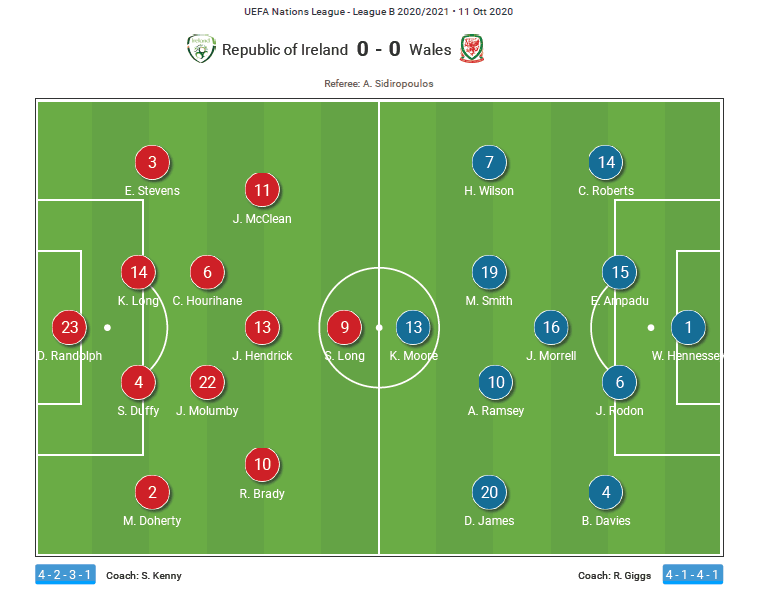
Ireland: 4-2-3-1
Making several changes to the side that lost on penalties to Slovakia in the EURO 2021 Qualifiers on Thursday night after 120+ minutes played, Kenny’s side did not lack belief or courage to attack an in-form Wales side to get a result.
Wales: 4-1-4-1
Similarly, Wales would have suffered a dip in confidence after 3-0 thrashing by England this past week. However, Manchester United Legend Giggs certainly set his side up to get a result away from home.
This formation gave Wales a balanced shape in transition, with three in the middle neutralising Ireland’s midfield, with plenty of attacking potential on the wings and up front.
Ireland’s controlled build-up
Although Ireland have not found the net in their last three competitive fixtures, the boys in green are looking a much-improved side on the ball under Stephen Kenny. Kenny’s side played some fast, fluid football at times, showing greater confidence and ability to build from the back under pressure and commit defenders to the final third.
Ireland lined out in a 4-2-3-1, with the clear intention to build through the thirds whether Wales applied pressure or sat off. Even in the transition to attack, those moments where Ireland could spring a counter-attack from the middle third, they opted for a safe back pass to the centre-backs to restart the attack.
Ireland would create overloads from deep by having one of the two holding midfielders drop alongside the centre-backs to create a +1 overload against the front two of Wales. From here, the boys in green were able to discover line-splitting passes forward or space to carry the ball into the middle third.

Above, we see the passing options made available by this movement, as CDM Conor Hourihane dropped deep beside the centre-backs this allows Ireland to create passing options forward. Notice the passing options available due to the movement of the Irish midfield.
The full-backs Enda Stevens and Matt Doherty were integral to the Ireland attack as they were present in every third of the pitch to create overloads in wide areas as well as progressing the attack into the final third with penetrating passes and crosses.
As the full-backs created the width and the centre-forward Shane Long created the depth, this allowed the five midfielders to move freely and efficiently in the middle third. Jeff Hendrick (CAM) and Robbie Brady (RM) exercised a lot of lateral rotations while James McClean was able to step into the half-space unmarked to as the left-back Stevens operated in the channel.
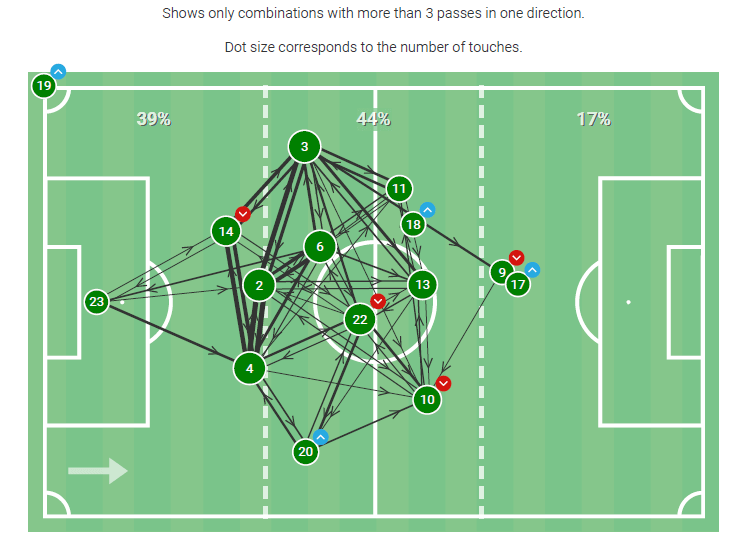
The data above shows Ireland’s passing network in the game, note the data accounts for passing combinations of three or more passes in the final two-thirds of the field while also accounting for each player’s average position and volume of touch. Observe the narrow positions of the Irish midfield as well as the density of passes across all three units.
Below we will look at two common patterns exercised in the Irish attack.
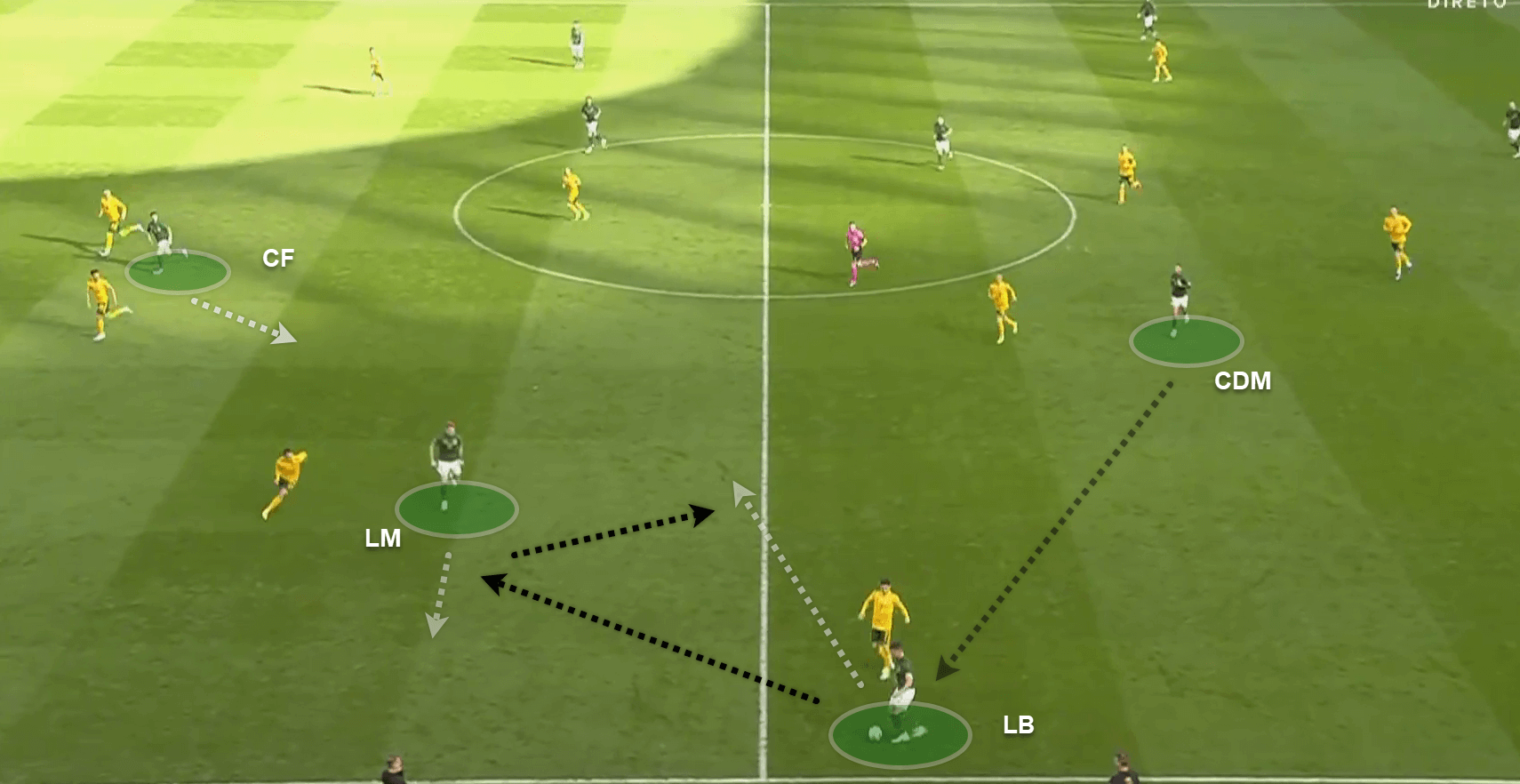
Above, we see left-back Stevens receives a pass from the midfielder Hourihane. Stevens plays a one-two with McClean as both players make a lateral rotation, creating space for each other to pass and receive.
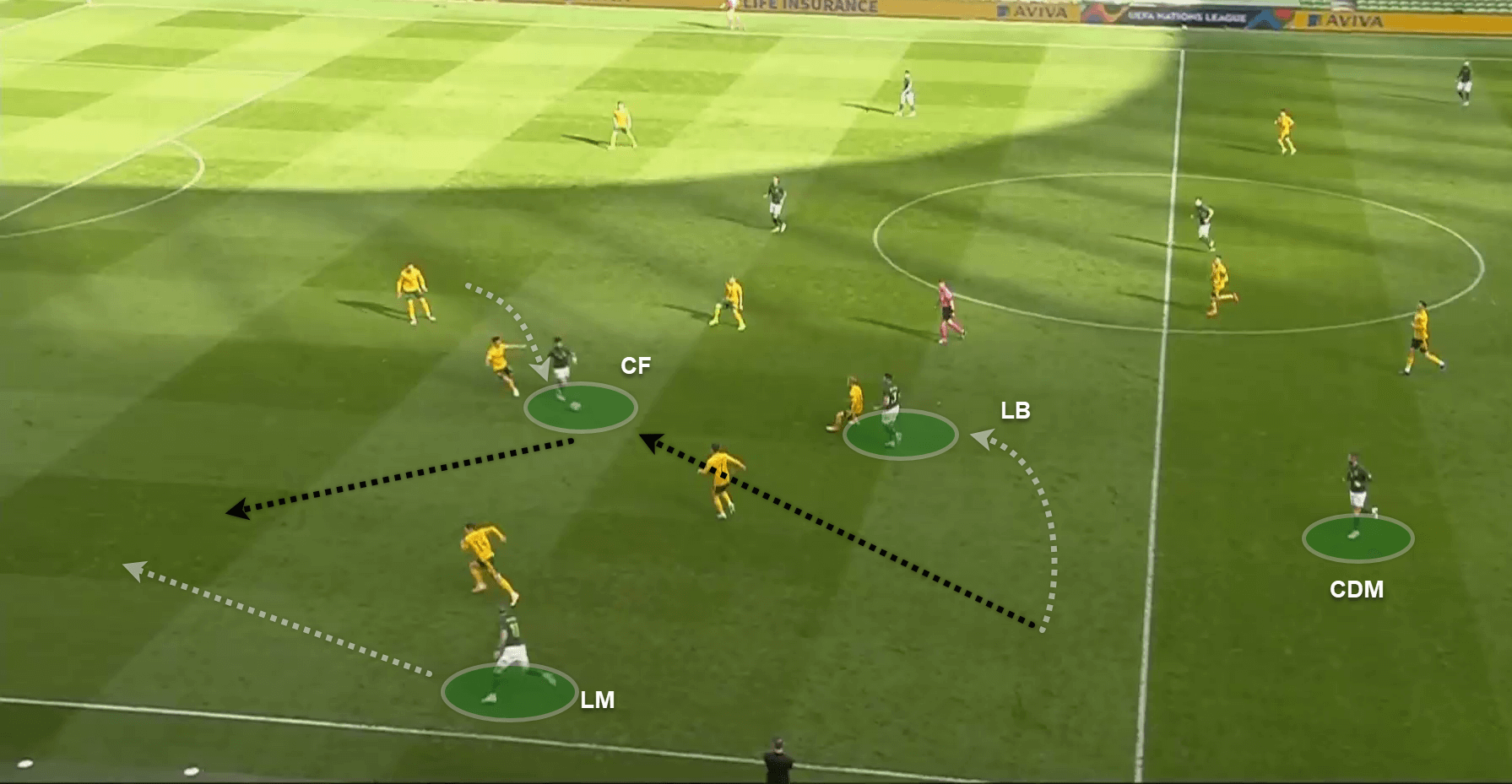
As Stevens gets the ball back, he plays a one-touch pass into the feet of the centre-forward Long. Long then adjusts his body to play a forward pass into the channel to meet the run of McClean driving into the final third.
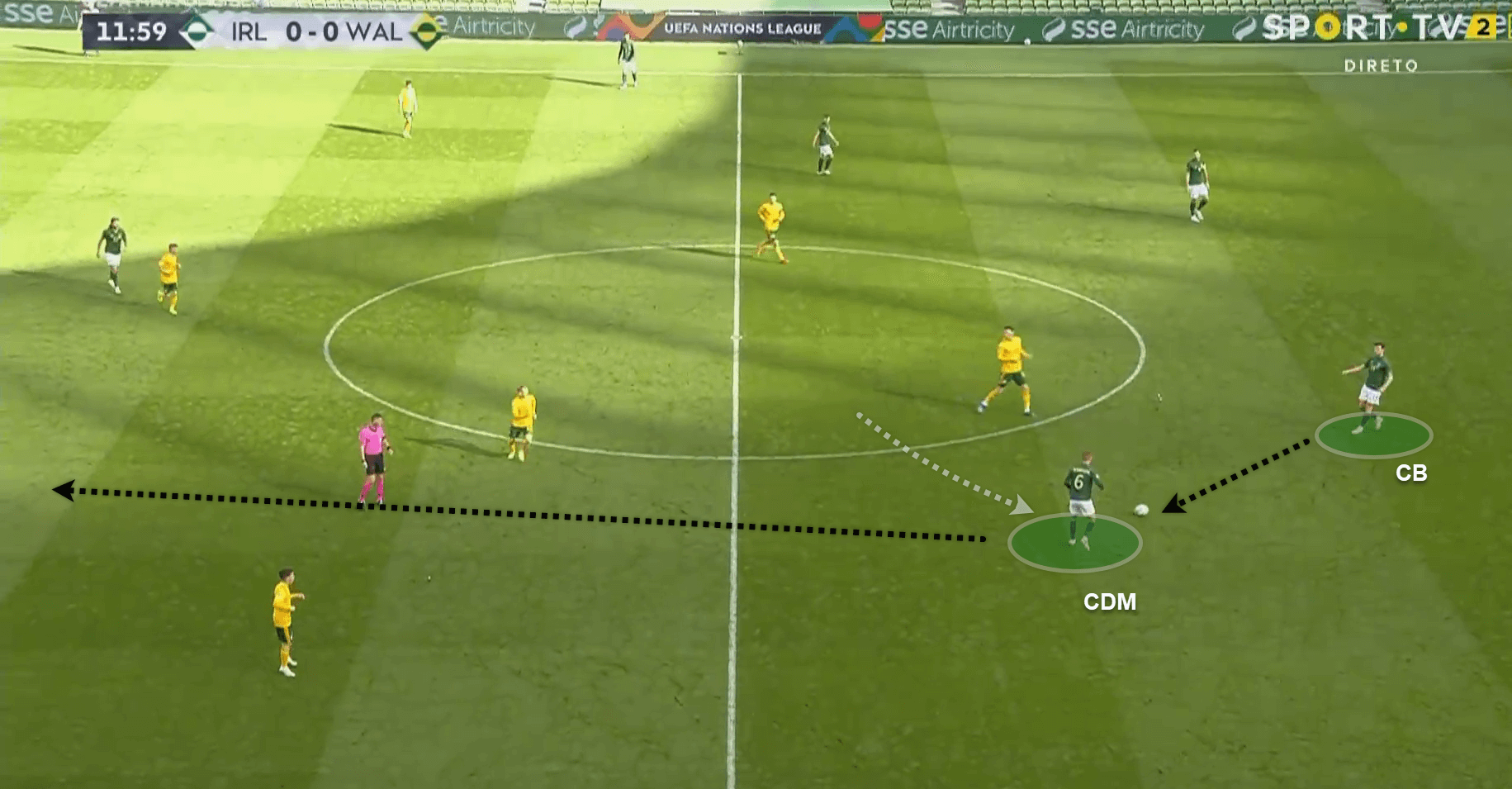
Above, we see another example of how Ireland create forward passing options by creating overloads in the half-space. Again Hourihane comes deep to receive a short pass from the centre-back. Hourihane turns to play a pass forward to McClean who is just out of frame right now.
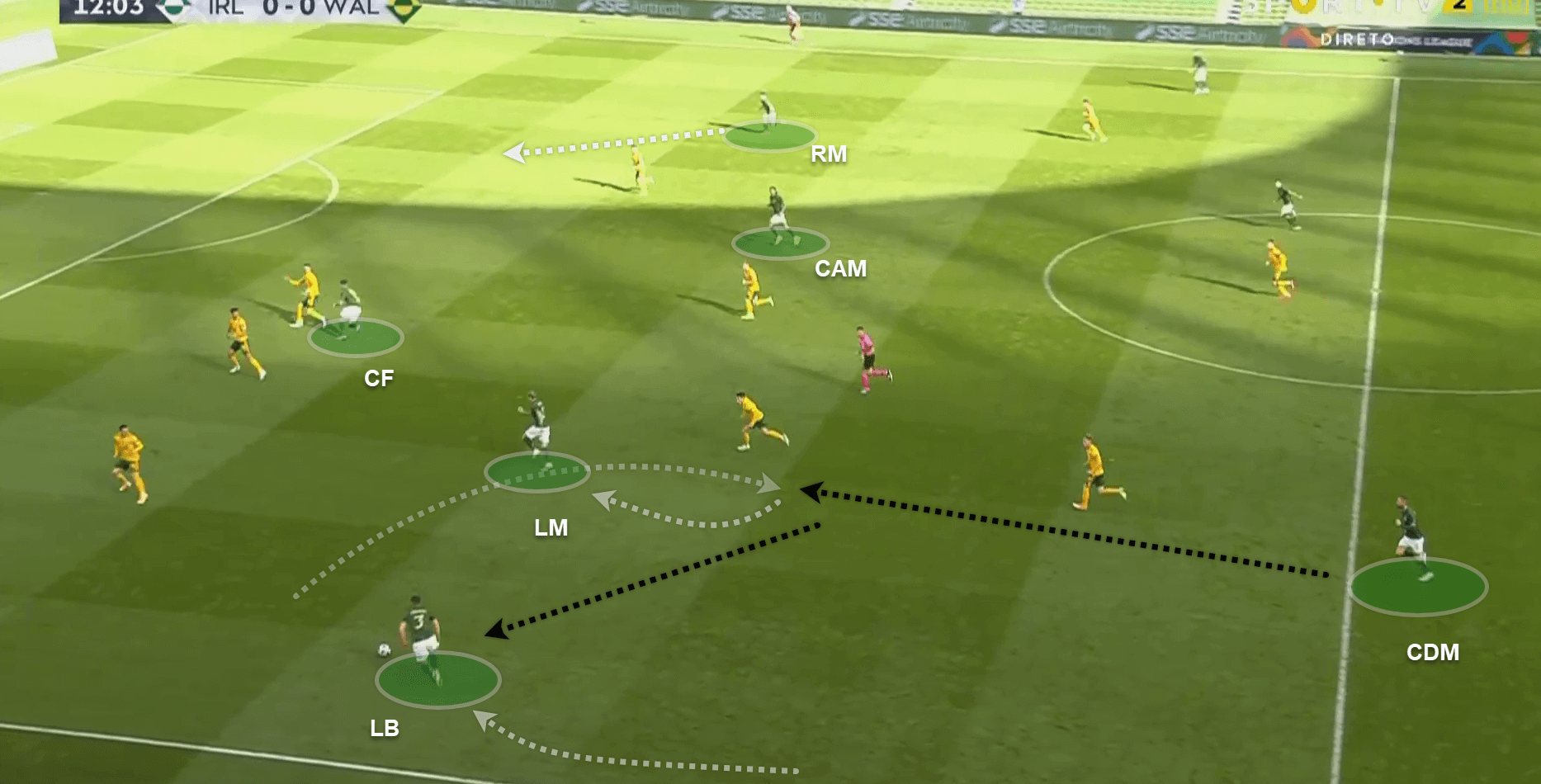
McClean then plays a one-touch pass out to the left-back who then carries the ball into the final third. This passing move would not be possible without the fluid movement of the left-midfielder McClean who moves to receive the pass in between the lines unmarked.
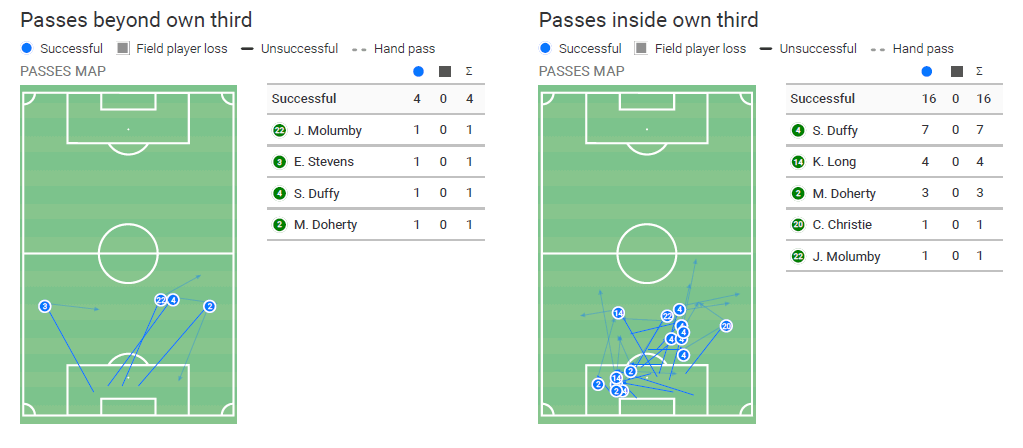
It must be said, considering the pressure Ireland were under at times when Wales applied a high-press, goalkeeper Darren Randolph did superbly to achieve a 100% passing accuracy for all short and long passes as we can see above.
Ireland did well to control the game with the ball, discover passing opportunities out of danger, and build intelligently into the final third. However, it was here in the final third where the boys in green came unstuck as they searched for that final product in front of goal.
Ramsey’s key role in Wales attack
In attack, Wales set up in a 4-4-1-1, with Aaron Ramsey playing as the ’10’, it seemed if anything were going to happen by way of finding the net, it would be from Ramsey’s invention to create or finish. As Wales were keener to go forward in the transition to attack, this meant the opportunities to build from the back with structure came few and far between.
Similar to Ireland, Wales had a similar shape when building from the back; however, with midfielders being more stagnant and immobile at times, it was difficult for the Welsh defenders to play forward centrally. As a result, Wales looked to find the answer in the wide areas.
As Ireland were playing with two holding midfielders, it was difficult for Ramsey to be a forward passing option in the central areas, meaning the Juventus midfielder had to move into the channels to create overloads and unlock the Irish defence.
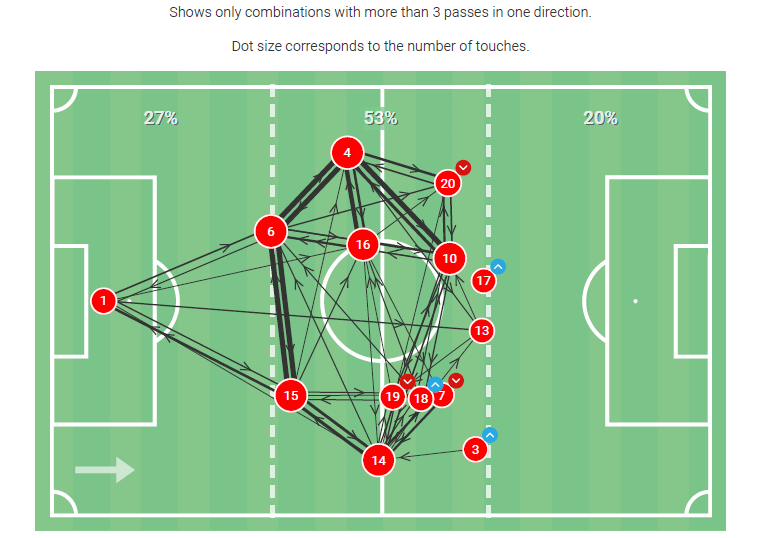
Above we see the pass map for Wales, observe the density of the lines that connect with the ’10’ Aaron Ramsey with the surrounding players, particularly the left-back ‘4’.
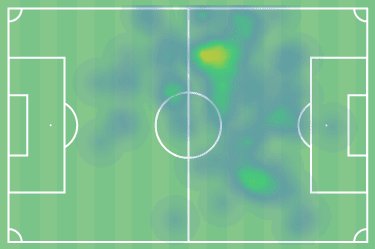
Above is Ramsey’s heat map across 90+ minutes of this match. Notice the lateral movement as well as the willingness to come deep to receive and create attacks. Ramsey would often step into the channels while the full-back and wide-midfielder would move into the half-space to unbalance the Irish defence and create overloads to play into the final third.
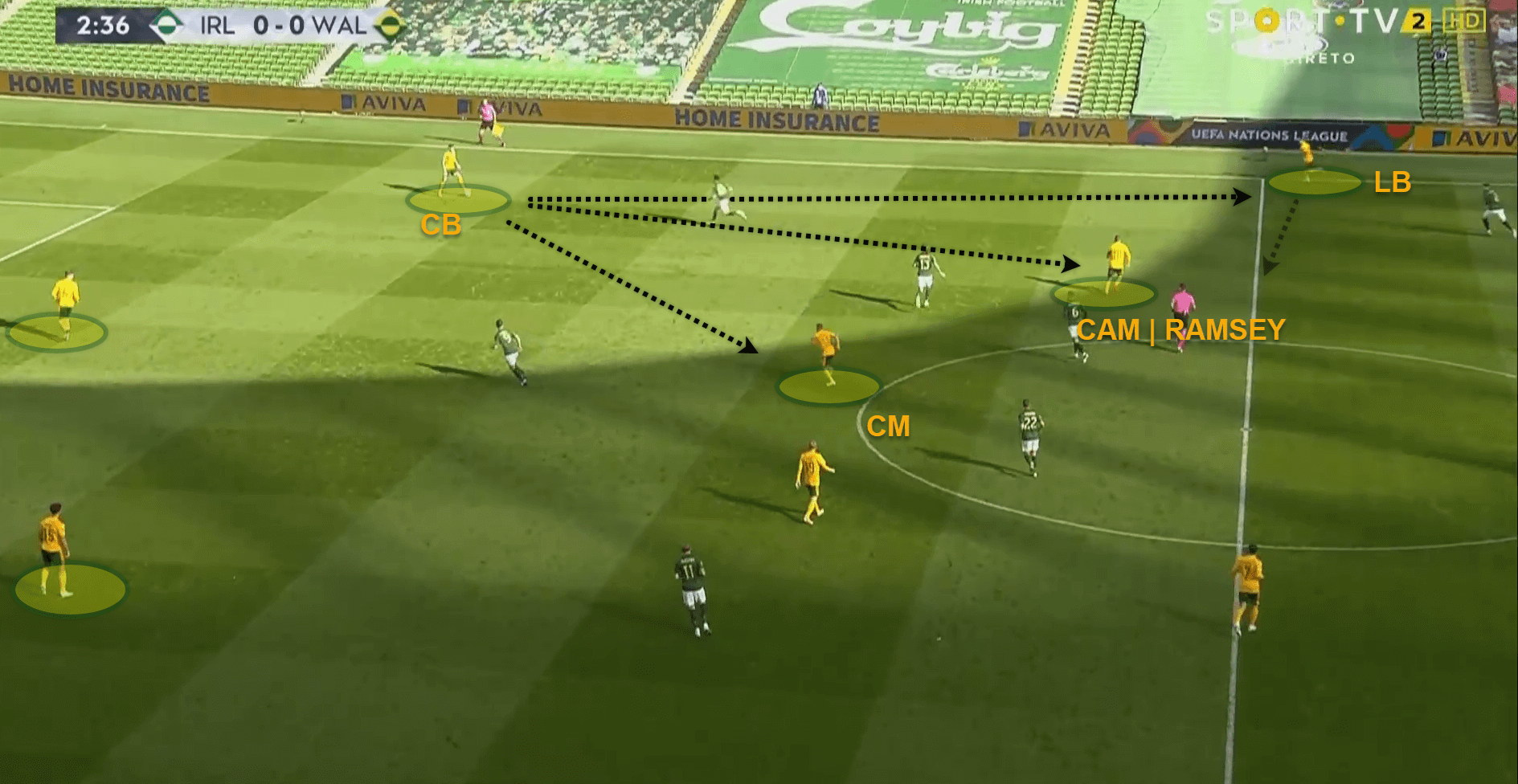
Above, we see a moment where Ramsey comes short to create a forward passing option into midfield. Ramsey drops into the half-space on the same side as the ball-carrier. By doing so, one Irish player has to leave his man to screen the pass to Ramsey, which opens up a pass to either the full-back or the central-midfielder. On this occasion, Ramsey gets a lay-off from the full-back, and Wales move into the final third.
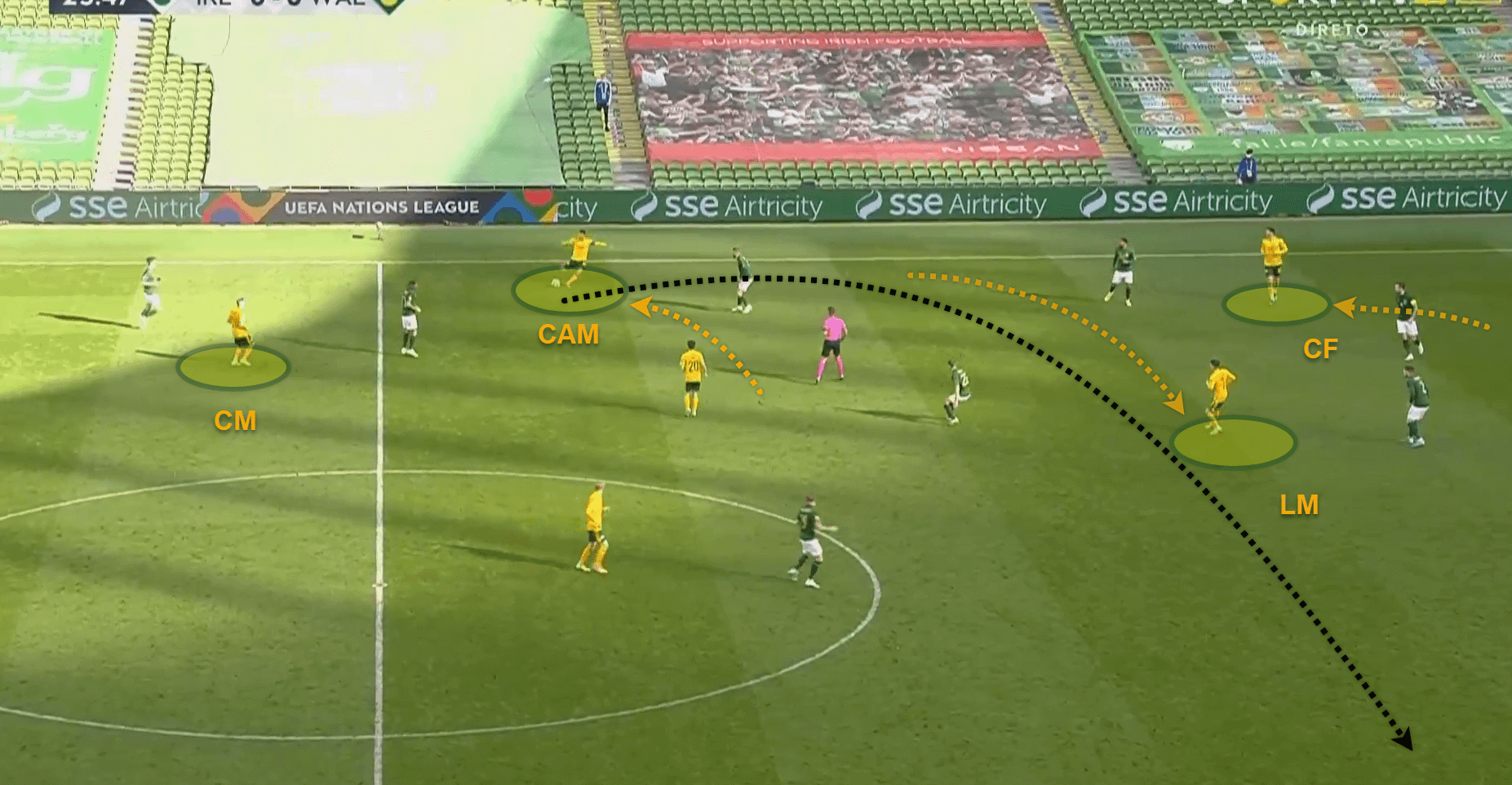
Above, we see another common pattern in the Wales attack, where Ramsey receives in the channel, as Ireland are compact on that side the Juventus midfielder picks out his countryman on the Irish weak-side with a long driven pass to the chest of the Welsh right-midfielder, Harry Wilson.
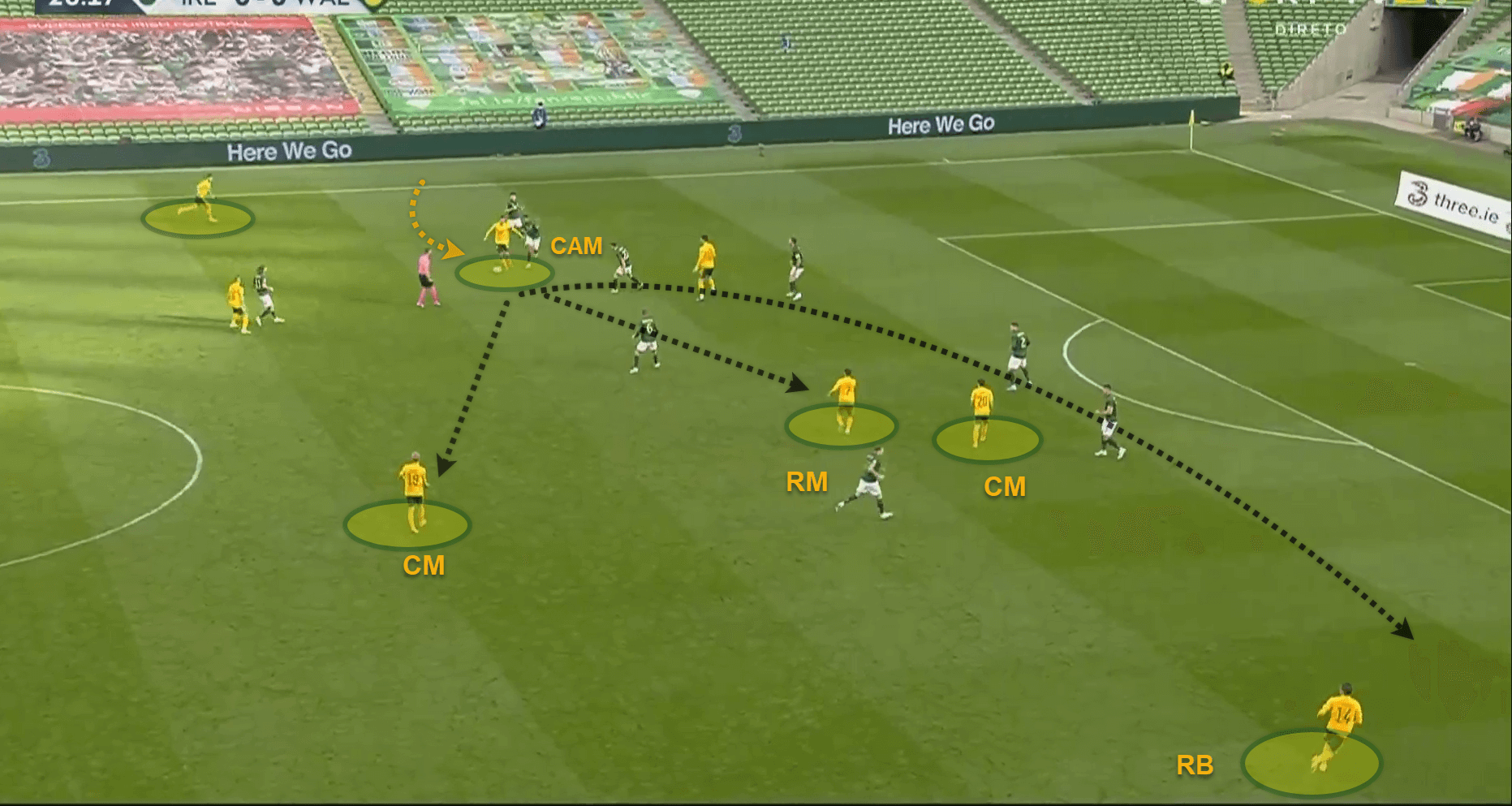
Once again, as we see above, right-footed Ramsey delivers a lofted pass to the Irish weak-side, inside the final third. It was a pass made possible by Ramsey’s ability to dribble past two green jerseys, look up, and deliver a pass.
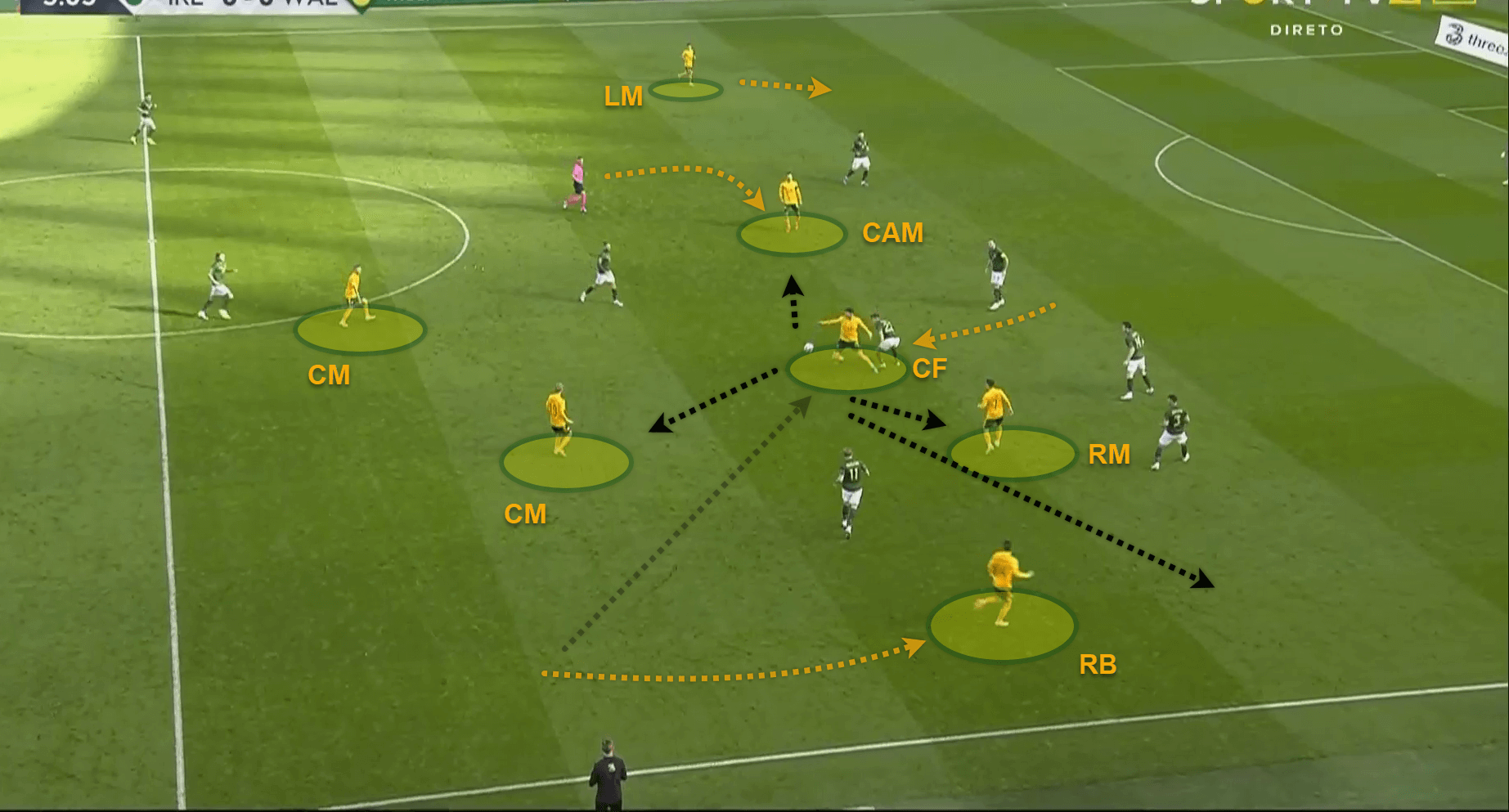
Above, we see Ramsey’s movement when Wales play directly to the centre-forward Kieffer Moore. Moore holds up the ball to bring others into play, as the wide players push on ahead of the ball, Ramsey occupies the number ‘9’ position. Ramsey showed good game IQ, however, there was more to ask for from his teammates as Wales went in search of the opening goal.
Wales only amounted an xG rating of 0.37 and with only two attempts in target from six efforts on goal. Wales boss, Ryan Giggs will need to get his players back to the training ground if they are to improve on their chances going forward.
Ireland still without identity in the final third
It has to be said about Stephen Kenny, that for his side to be playing this well without any recent results to give them confidence, is a testament to his coaching and his ability to get the best out of the players.
Ireland fans are now seeing their national side develop an identity with the ball, the likes we have not seen before, a type of football to compete in the modern era, and they are improving game by game.
We are seeing a lot more fluid attacking football from back to front, not least to see an Ireland side play one- and two-touch football out of pressure just outside their box speaks volumes for what Kenny has done, and what he will continue to develop. However, right now, Ireland looks without a purpose and a plan in the final third.
Untimely crosses with no runs to match, players doubling up for the same ball to strike, changing from inverted wingers to cut inside to orthodox wingers forced out, and backwards for a pass. It’s not clicking just yet for the boys in green, however, in the coming months, it’s likely this style of football will deliver the final product.
Against Wales, Ireland only managed 1 attempt on target from 9 shots and accumulated an xG of 0.67. A rating and a shot statistic that could have easily improved with fine-tuning in the final product.
Let’s examine some of the missed opportunities in front of goal.
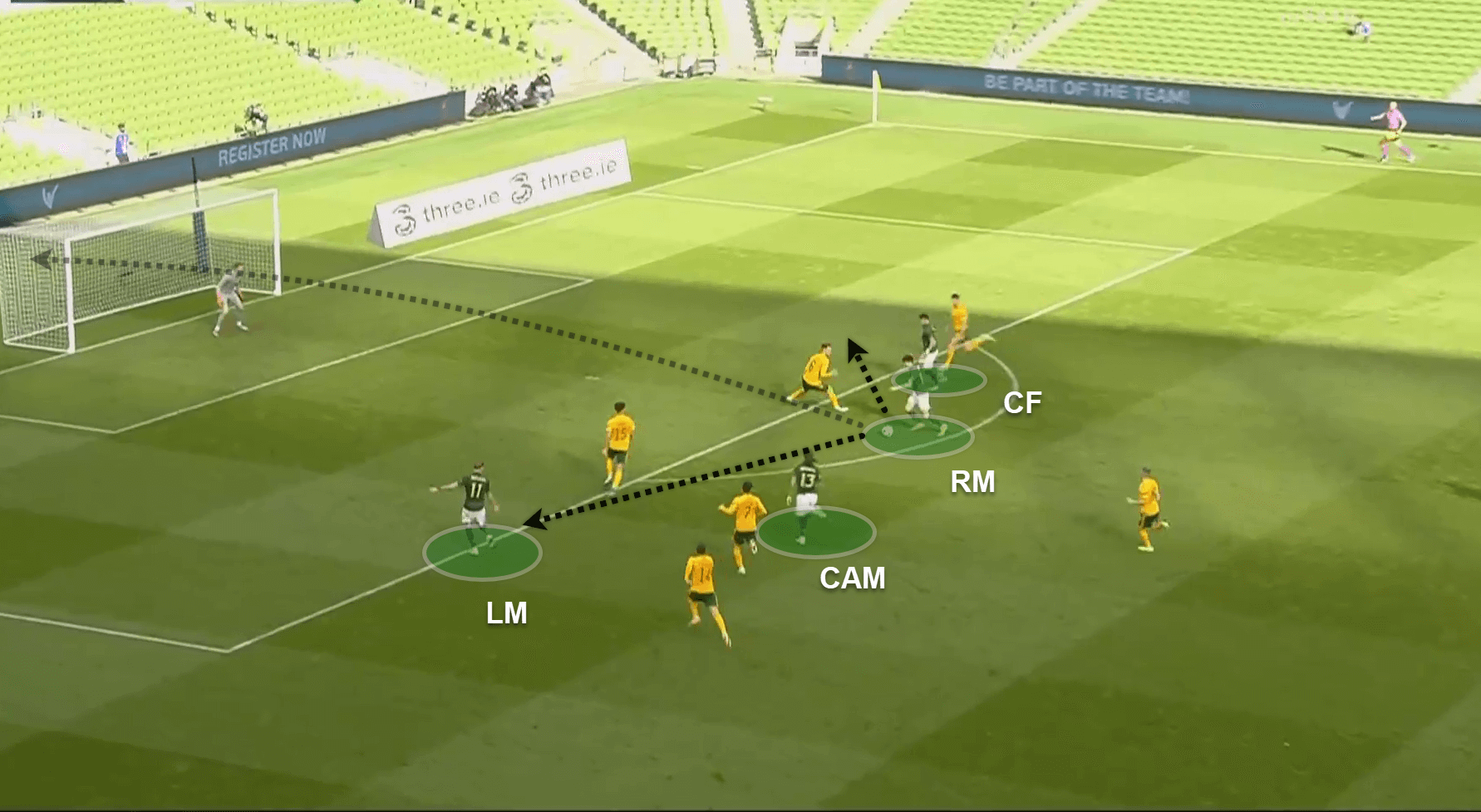
Above, we see Robbie Brady engages the last defender before having a strike wide of the target. Perhaps a pass to either attacker on his left or right would have given Ireland a better opportunity to convert.
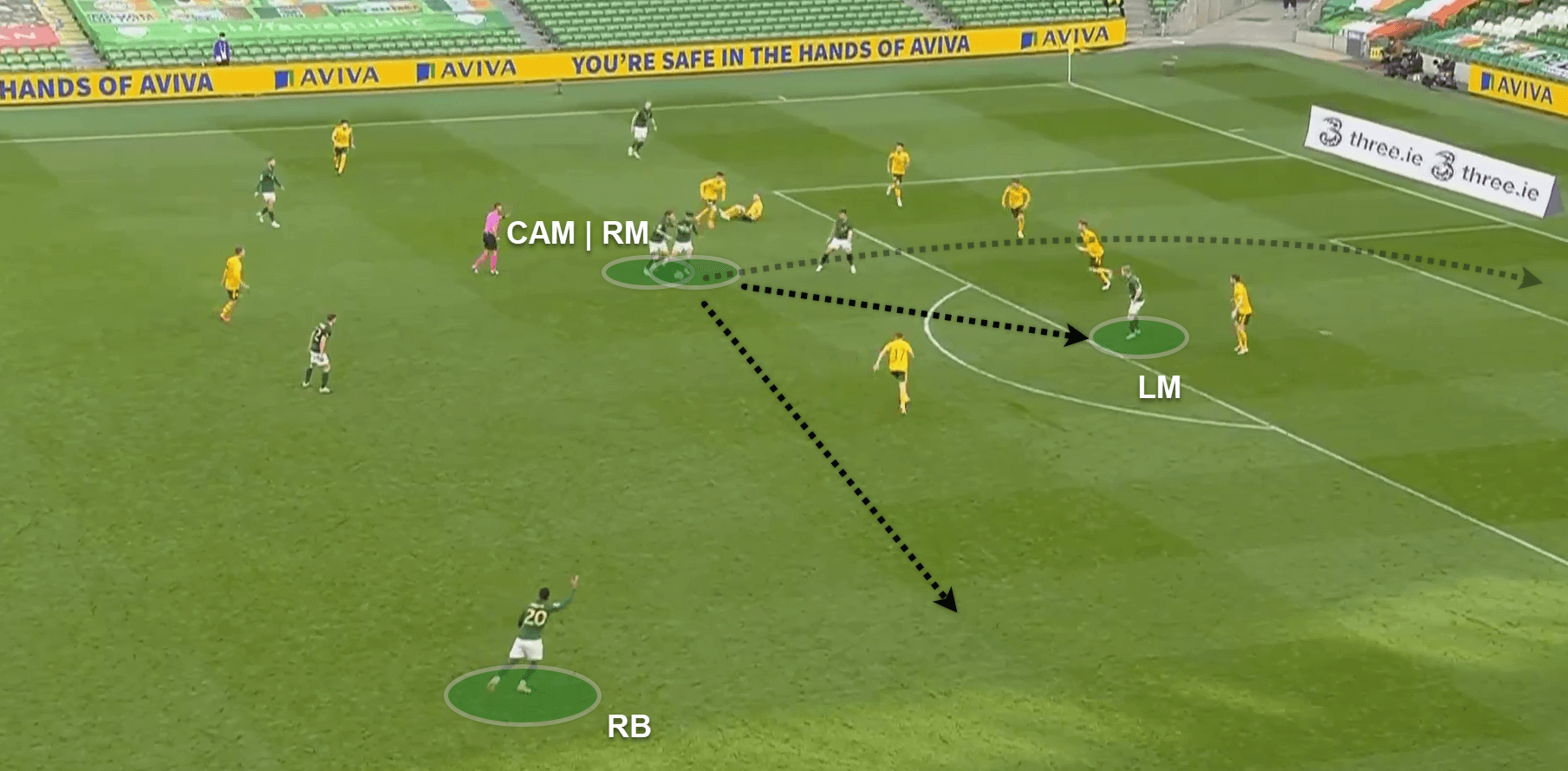
Above, we Hendrick and Brady look to claim the ball at the same moment, Hendrick keeps possession, shrugs off the pressure from his teammate before having an unconvincing attempt on goal. Notice how right-back Osiris Christie to the right is in a good position to progress the attack. At the same time, McClean up in front can also be of service to create a better chance.
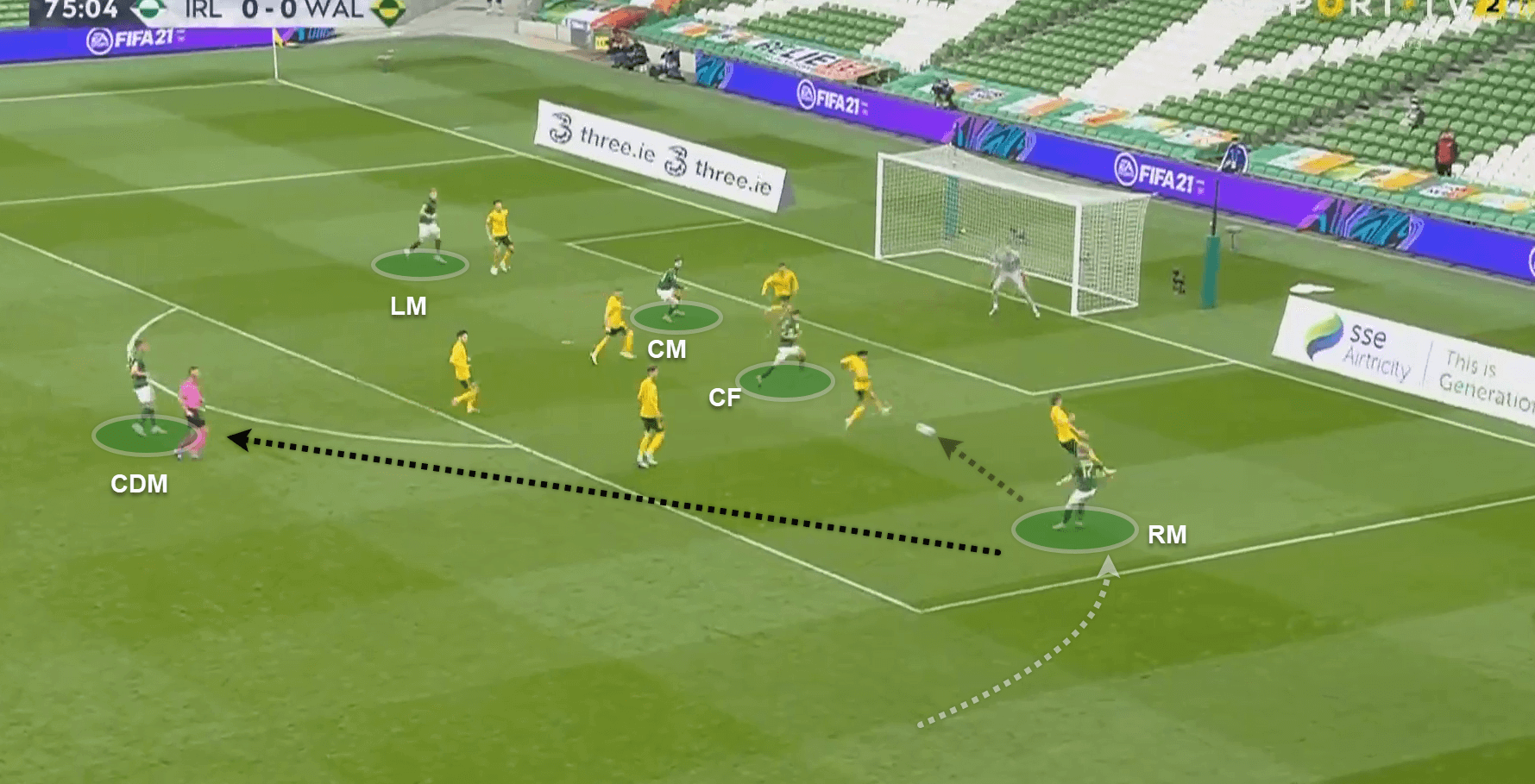
Finally, we see a moment Darryl Horgan delivers a low-cross which is blocked by the first defender. At this moment, Wales are well balanced and in a good position to defend a cross. Perhaps an earlier delivery before Wales had time to screen the pass or even if Horgan had stayed in possession and looked to engage the defender inside the box in a 1-v-1 might have given him another reward.
The resounding message here is that Ireland are an improving side under Kenny, looking more comfortable with the ball. However, with the cluster of games coming thick and fast as well as having played 120+ minutes of football for the previous three nights, it was a lot to ask for the boys in green to be sharp in front of goal against a tough Wales defence.
Conclusion
Ireland look much improved since Kenny’s first game in charge; the fixture pileup has not allowed either manager to put their best foot forward, yet Ireland look an improving side in and out of possession under this new manager. 120+ minutes of competitive game minutes only days earlier would have waned on this Irish performance, but there will be a lot of positives to take away from this game.
Similarly, Wales boss Giggs will feel his side could have claimed more for their spirited performance. The return of Gareth Bale cannot come soon enough as Wales look for some inspiration in front of goal, as the former Real Madrid frontman is nursing a knee injury.
To track the progress of both of these sides, be sure to check back in with us following the next round of UEFA Nations League games.

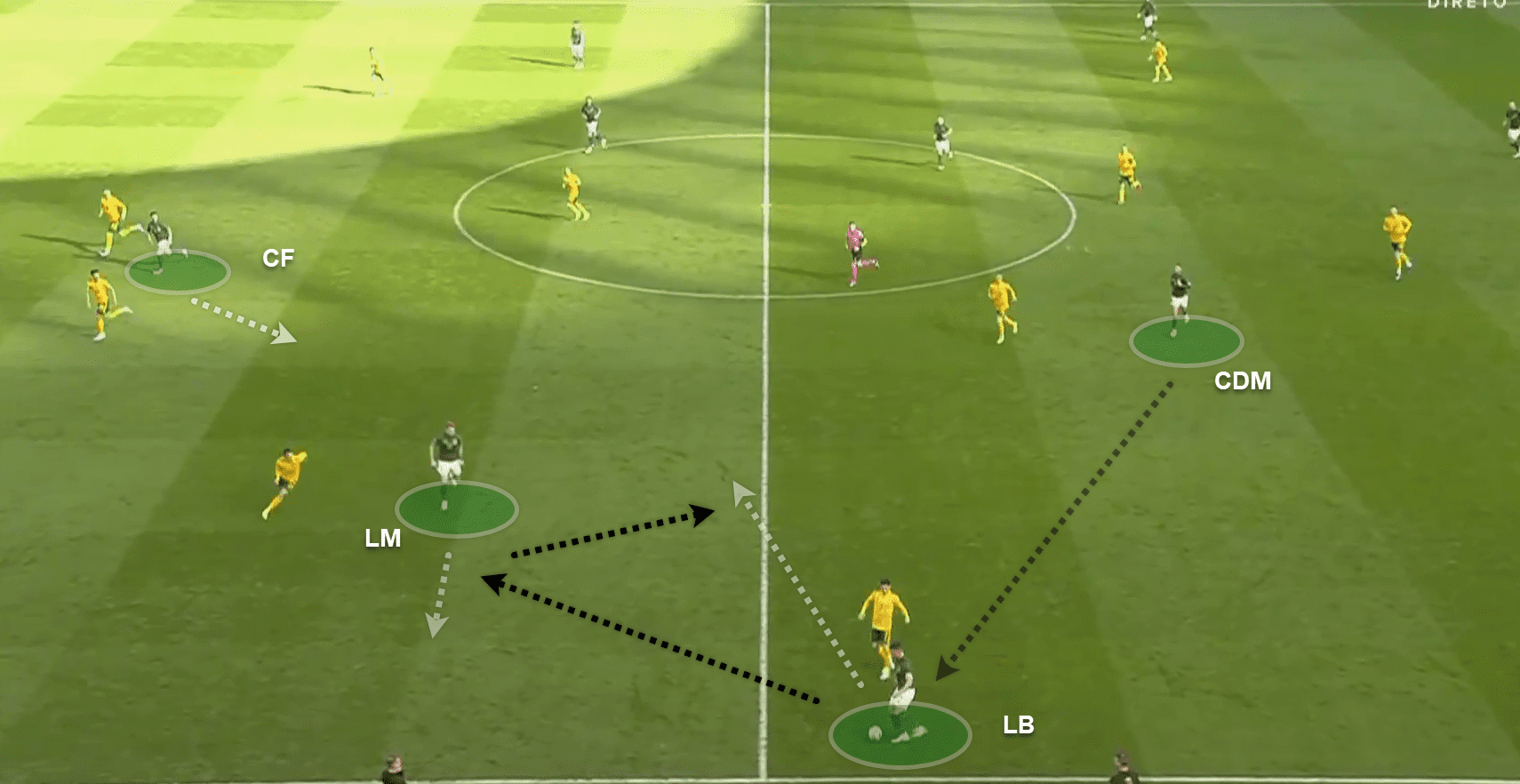



Comments